The Dalai Lama from a Catholic perspective
by Alexander Norman
Contents
- Origins
- The Dalai Lama Institution
- A Brief History of the Dalai Lamas
- The Buddhism of Tibet
- The Dalai Lama as Reincarnation
- The Tibetan Folk Tradition
- Of Magic and Mystery
- The Dalai Lama’s Religious Pluralism
- The Dalai Lama’s Spiritual Teachings
- The Dalai Lama’s Message to the World
- The Significance of the Dalai Lama
- Notes
Origins
Feted by politicians, by pop-stars and by millions of ordinary people alike, the Dalai Lama is one of the best loved spiritual leaders of modern times. His talks sell out sports stadia from Sydney to San Francisco, from Oslo to Johannesburg. He is the recipient of a Nobel peace prize, a Congressional gold medal, the Templeton prize for spiritual progress and numerous other awards both civic and academic. A man of clear personal sincerity, the Dalai Lama’s message of peace and compassion wins him friends wherever he goes.
Thanks to an upsurge of interest in Tibet and in the Buddhism of Tibet, the Dalai Lama’s story is well known. At an early age, he became paramount leader, both spiritual and temporal, of the Tibetan people. In 1959, he was forced to flee his country for exile in India following its annexation by the People’s Republic of China which claims Tibet as sovereign territory. Since then, the Dalai Lama has travelled the world seeking to advance the cause of political autonomy for his people and at the same time expounding a philosophy of non-violence based on universal compassion.
Born in eastern Tibet in 1935, Tenzin Gyatso, the present Dalai Lama, is acknowledged by his people as the reincarnation of the Thirteenth Dalai Lama who died in 1933 at the age of 56. According to his own account, the recognition process involved a series of prophetic signs as well as more than one interview. On the last of these, he was asked to identify a number of items that had belonged to his predecessor from among a collection of other, similar items. It was considered particularly auspicious when the infant Dalai Lama (he was just three years old at the time) picked up a walking stick and then put it down in favour of another one. The walking stick he first picked up had originally belonged to the Thirteenth, but he had given it away to a friend. The walking stick which the child picked up next was the one which the Thirteenth had at the end of his life.
The Dalai Lama is, however, at pains to admit that he remembers nothing of all this process and has often alluded wryly to the autobiography of the Fifth Dalai Lama. It seems that the young Fifth was completely unable to identify any of his predecessor’s belongings. As a result, the official conducting the interview had to ‘choose’ for him.¹
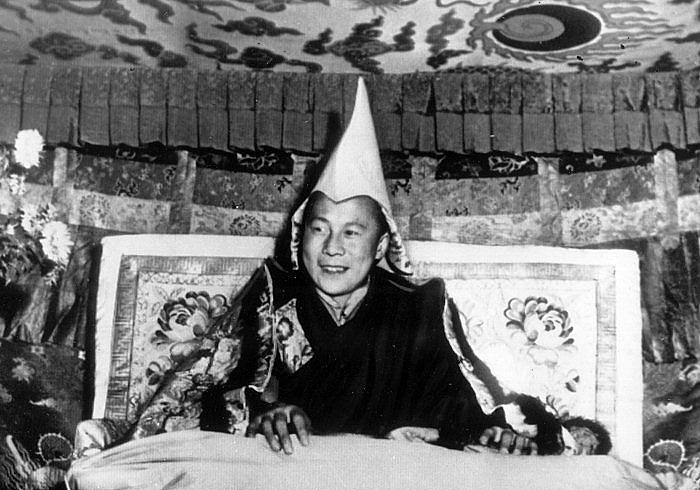
The Dalai Lama, seen here as a 15-year-old ruler of Tibet.
Image: Lowell Thomas Jr / Associated Press
The Dalai Lama Institution
The present Dalai Lama is 14th in a lineage which dates back to the end of the fourteenth century when the first incumbent was born. It is thus a comparatively recent institution. In fact it is even more recent than it seems since it was not in fact until 1578 that the missionary monk, Sonam Gyatso (1543-1588) was proclaimed Dalai Lama. But because he himself had been recognised as the reincarnation of two earlier spiritual masters, it was logical to confer the dignity on his predecessors. Hence the ‘first’ of the Dalai Lamas came subsequently to be known as the Third.
Yet although the Dalai Lama institution is less than five hundred years old, it is nonetheless embedded in a much older tradition. As such, each successive Dalai Lama is regarded as a member of a spiritual lineage which can be traced back in time to that of the historical Buddha himself. This was Shakyamuni who lived probably four to five hundred years before the time of Christ. For Tibetans, this much longer lineage is important because it links the Dalai Lamas not only with other important religious figures but also to three powerful Tibetan kings who reigned more than a thousand years ago.
There is yet another tradition in which the Dalai Lama institution is embedded, however. This one looks even further back – to a time nine hundred and ninety eons ago.² This tradition is significant because it connects the Dalai Lamas to Chenresig, one of the most important figures in the Buddhist tradition, who is said first to have arisen at this time.³
A Brief History of the Dalai Lamas
Of the fourteen Dalai Lamas to date, two are considered ‘Great’. These are the Fifth and the Thirteenth, although there are many Tibetans who already speak of the Fourteenth in the same terms. Both the Fifth and the Thirteenth Dalai Lamas were strong political leaders. The Fifth was largely responsible for re-unifying the country, under the protection of Mongolian warlords, for the first time since that of the Tibetan Empire of the 7th-9th centuries. It is a little-known fact that Tibet was at that time among the pre-eminent trading nations of South-East Asia, controlling much of the famous Silk Road linking early mediaeval Europe with China.
For his part, the Great Thirteenth was the Dalai Lama who restored Tibetan independence after centuries of Chinese domination. This he was able to do by exploiting China’s weakness following the overthrow of the Manchu Qing dynasty in 1912. He subsequently built a relationship with the then British government of India.
Of the other Dalai Lamas, the First was an important scholar saint, though he is generally agreed not to have been the foremost of his time. The Second is revered as a great visionary and spiritual leader whose works are studied by Tibetans monks to this day. The Third Dalai Lama, who, as we have seen, was the first to be recognised, was a missionary monk who took the faith to the Mongolians. It was in fact a Mongolian chieftain who conferred on him the title Dalai Lama.⁴
The Fourth is considered the least successful of all the Dalai Lamas. He was himself Mongolian, a distant relative of Genghis Khan, and not Tibetan at all. The Sixth, revered as the country’s greatest love poet, was a womaniser and drunkard who refused to take his final religious vows. His successor, the Seventh, is regarded as a particularly saintly man, although he was notably sectarian. The Eighth, a sickly youngster, deferred his enthronement and, on reluctantly assuming power, relied heavily on his former regent during the two years he held office. The Ninth, Tenth, Eleventh and Twelfth Dalai Lamas all failed to make any impact, three of them dying before they attained their majority. It is widely accepted that some or all of them were murdered either at the behest of Tibet’s Manchu overlords or by factions within the Tibetan court itself.
The Buddhism of Tibet
As the Dalai often asserts, there is actually no such thing as Tibetan Buddhism if that means a Buddhism unique to Tibet. The Dalai Lama himself practices Mahayana (Great Vehicle) Buddhism. But within this, he is also an exponent of Vajrayana (or Diamond Path) Buddhism, a late development within the tradition considered by its exponents to be the highest, most fully developed form of Buddhism. Yet while both Mahayana and Vajryana Buddhist practise has for the past millennium been largely confined to Tibet and Mongolia (though recently it has gained favour in many western countries, especially America), historically it was important in Central Asia and northern India. When we speak of Tibetan Buddhism, what we mean therefore is the form of Buddhism that has developed over the centuries in the Indo-Himalayan region, and is practised principally by peoples of Tibetan ethnic origin but also by Mongols, Buryats and others.
So far as their own position within the Tibetan spiritual tradition is concerned, the Dalai Lamas are members of the dGe lugs (pronounced gelug) school. This is one of four principle schools or sects within Tibet (the others being the Nyingma, the Sakya and the Kagyu). Perhaps surprisingly, however, he is technically just an ordinary member of a monastery of which he is not abbot. Nor does he appoint other lamas, as the Holy Father appoints all bishops.
Although from the perspective of some other schools within the larger Buddhist tradition, some of the doctrines and practices upheld by the Dalai Lama are not always considered to be wholly orthodox, the Tibetan spiritual masters themselves place great emphasis on authenticity. In the end, the argument comes down to the question of whether or not the Mahayana teachings, which clearly did not appear until several hundred years after the death of the historical Buddha, are to be accepted.
The Dalai Lama as Reincarnation
The word lama in Tibetan translates the Sanskrit word guru meaning teacher. A lama is therefore someone who teaches. And what he teaches is the buddhadharma: the path to liberation expounded by the Buddha. They are thus teachers of religion.
As to what it means to say that the Dalai Lama is a reincarnate lama, here we need to understand some basic principles of the Buddhist tradition. First, it is important to realise that, whereas the aim of Christian spiritual practise is eternal life with God, for the Buddhist it is Enlightenment (Pali/Skt. bodhi; Tib. byang chub, literally meaning awakening [from ignorance]) which is conceived of in terms of liberation from samsara, the wheel of suffering. The Buddha Shakyamuni is held to have attained full Enlightenment at the age of 35, after which he spent the remainder of his life teaching others the way of liberation. However, from the specifically Mahayana Buddhist perspective, although Buddha Shakyamuni is a fully Enlightened being, he is but one of many. Furthermore, in Mahayana practise, stress is placed on how certain of the most highly spiritually advanced beings, out of their boundless compassion for others’ suffering, though they are on the verge of Enlightenment, postpone it in order to dedicate themselves to serving all other sentient beings and so to help them attain spiritual perfection. Among these highly evolved spiritual beings is Chenresig, also known as the ‘bodhisattva of compassion’, of whom the Dalai Lamas are said also to be emanations. As one of the Dalai Lama’s favourite prayers promises, he will not take final liberation until all others have attained release from suffering.
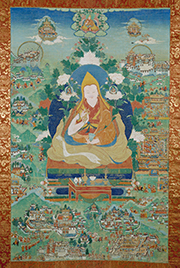
The Great Fifth Dalai Lama, Ngawang Lobzang Gyatso
(1617–1682)
© Rubin Museum of Art
To begin with, therefore, it is important to recognise that the Buddhist idea of re-incarnation is quite different from anything that might be imagined by a person familiar with the Christian concept of Christ’s Incarnation. This states that the eternal Son of God took flesh of his human mother, the Blessed Virgin Mary, and was made man, with a human soul, while yet remaining the second person of the Trinity.
It must also be understood that Buddhism does not accept the possibility of a Creator god, a necessary yet personal being who brought the world into existence ex nihilo. Indeed, this a-theism is true of all Buddhist traditions. Each holds the view that there was no moment of creation out of nothing. Rather, Buddhists believe that there is a simultaneous multiplicity of universes, all of them without beginning. On the other hand, it is important to realise that Buddhism is in an important sense not atheist at all. It accepts the existence of innumerable gods, deities and demons – but with the proviso that, in common with all phenomena, these are, ultimately, illusion-like. They have no independent existence.
Another fundamental doctrine of Buddhism is the doctrine of no-self, or Not-Self. According to this, there are no selves (understood in the sense of an enduring and unchanging transcendent entity) which could be enfleshed. Instead, from a Buddhist perspective, the ‘self’ is a construct built out of a web of interconnected causes and conditions. As such, what is habitually taken to be the ‘self’ is, in the final analysis, an illusion – or, more accurately, illusion-like. It is axiomatic for the Dalai Lama that, one way or another, nothing exists or obtains that does not depend on other causes and conditions. This is one reason why God, as understood by the Catholic Church cannot exist for Buddhists. God is independent of all causes and conditions.
Buddhism understands the ‘selfhood’ of sentient beings (that is, of humans, animals, insects and so forth, but also the simplest organisms such as amoeba as well as gods and ghosts) as being crucially related to the streams of consciousness which are inherent to them. From a Buddhist perspective, an individual being’s stream of consciousness is that to which the accumulated karma of that entity attaches.
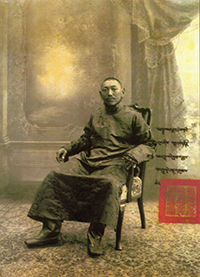
The Great Thirteenth Dalai Lama, Thubten Gyatso (1876–1933)
Now in English, the word karma is often taken to mean something like a person’s destiny. It is said that such and such an event is ‘just karma’. But this is inaccurate. The word karma, in Tibetan, leh, literally means action. It is held that any intended action performed by a sentient being (again, not just humans but any being with consciousness) will generate a positive, a negative, or a neutral ‘karmic imprint’ on that being’s stream of consciousness. And it is this accumulated karmic imprint which is what is transmitted over successive lifetimes, and nothing else.
Thus when orthodox Tibetan Buddhists speak of the Dalai Lama in terms of him being a reincarnation of the Great Thirteenth Dalai Lama, it would be wrong to suppose that they are necessarily talking of the reincarnation of a person as such. This would be both to contradict the Buddhist notion of no-self and what it means to say that karma is reincarnated. It is true that many unschooled in the higher doctrines would be likely to understand the connection just as the word reincarnation implies: a re-embodying of some essence. A better characterisation of the situation would be to speak in terms of an intimate spiritual relationship between the two earthly beings. Similarly, to say that the Dalai Lamas are also emanations of Chenresig is to say that, simultaneous to being intimately related spiritually to each of their predecessor Dalai Lamas, they are considered a direct manifestion of the accumulated karma of Chenresig which has been perfected through the ceaseless practise of compassion. They are thus closely connected to one another, but not identical in any crude way. Furthermore, insofar as their behaviour appears to fall short of perfection, this can be put down to the fact that appearances often mislead. Everything the Dalai Lama does, even living a dissolute life, as did the Sixth, can be seen as a teaching designed to help others attain liberation.
Does the Dalai Lama’s connection with Chenresig nonetheless mean that he is some sort of god? As a matter of fact, gods, or lha in Tibetan, are considered to be rather lowly beings, rather like the sprites and demons of traditional European folklore. He is certainly not a god in the Tibetan sense of the word.
The Tibetan Folk Tradition
With its denial of self, of a Creator and of a first event, Tibetan Buddhism can seem to be a rather austere faith, just as the Tibetan landscape seems to be largely barren, and beset with ‘dreadful and tedious solitude’, as Ippolito Desideri, the seventeenth century Italian Jesuit missionary to Tibet, recorded in his journal. But as Desideri was to discover, from a Tibetan perspective, this apparrently empty landscape teems with unseen life. There are gods of one sort or another – sometimes whole hosts of them – on every plain, in every tree and shrub, in every river, stream, lake, waterfall end even pond. There is no mountain, no valley, no field, nor any village or town without its presiding deity. All unusual rock formations, all precipices, all mountain crevasses are likewise the abode of some earth-dwelling spirit. And not only these but all birds of the air, all fish of river and stream and lake have their protective noumena – as, of course, do people themselves. Of these, there are regional variations but it is generally agreed there are five: the life god, situated at the heart; a male god at the right armpit; a female at the left; an adversary god (whose job is to protect us from enemies) at the right shoulder; a local god at the crown of the head.
The nature of the worldly gods is held to be broadly neutral, though some are essentially evil, and some good. But on the whole they are held to be haughty, touchy, vindictive, prone to anger and slow to forgive. As a famous American anthropologist, writing about the tent gods of the nomadic people, explained: ‘[they are] strange, jealous creatures [that] swarm at the rising of the smoke in a new tent, and take proprietary though at times perverse interest in the new hearth. Because of their displeasure, children die or are born dead. Their spiteful blows bring blindness, strange swellings and the swift rotting of anthrax… What tent can hope for peace if the hearthstone spirits are angry?’⁵
Although it is arguably true that belief in these traditional gods is waning to some extent among the urbanised younger generations of Tibetans, they remain important within the context of religious practise. The gods are still propitiated by the clergy in an effort to bring favourable outcomes: good harvests, safe journeys, recovery from illness and so forth.
If this seems paradoxical, given the fact that Buddhists do not accept a Creator, it is important to realise that the Tibetan gods, most of which are clearly survivals from the time before Buddhism reached Tibet, are considered to part of the natural order. They do not belong to another, transcendent world, but to this world. As such, they stand in need of salvation like all other sentient beings.
Of Magic and Mystery
The first European travellers known to have visited Tibet were all missionaries. The Fransiscan Oderic of Pordenone passed along the northern silk route on his way back from China in 1330. During the sixteenth century, the Society of Jesus established a mission at Tsaparang in south western Tibet. The first Europeans to reach Lhasa, the capital, were the Jesuit fathers Grueber and d’Orville. Later, contacts between Europe and Tibet grew more frequent firstly as a consequence of Britain’s presence in India and, towards the end of the nineteenth century, as a result of Protestant missionary work. At the same time, interest in Tibet as a place of magic and mystery began to grow in the European imagination.
The reason for this was largely due to the early visitors’ misunderstanding of what they saw of the Tibetan religion. The great exception to this was Desideri who not only learned the language and studied Buddhist philosophy but actually wrote three books, including a catechism, in Tibetan. Unfortunately, his subsequently written report was not published until two centuries later. In the meantime, much had come to be written about Tibetans’ supposed worship of demons and their frequent recourse to magic. The writings of Madame Blavatsky and other early Theosophists did much to popularise the notion of Tibet as a place where mystical secrets were guarded by the lamas – who were also accomplished exponents of magic according to them.
Part of the reason for this misunderstanding of Tibetan Buddhism, quite apart from the language difficulty, is that it is so closely bound up with the Tibetan folk tradition. Although, from the Tibetan perspective, the deities of the folk religion are bound over to the Buddhist faith, they are so unruly and unreliable as to require continuous supplication and even chastisement. It is easy to imagine how, as a result, Buddhist practise in Tibet did look a lot like demon worship to those early visitors.
As to the supposed magical powers of the Tibetans, the widespread practise of divination, either by use of mediums going into trance or by other means, is an obvious example of what, to European eyes, looked like a use of magic. The Jesuits spoke of it as an abomination. Yet from a Tibetan Buddhist perspective, it is a natural, and an important tool in furthering the buddhdharma. On this view, it is not to be conceived in terms of mere thaumaturgy or spirit worship and indeed the Dalai Lama is himself a keen exponent of different kinds of divination.
Interestingly, one particular practise which has drawn the attention both of those seeking marvels and of the modern scientific community is a form of yoga still popular in certain monastic quarters. To this day, it is customary for adepts to engage in competitions whereby the winner is the monk able to dry out the largest number of wet blankets using nothing but his own body heat. The blankets are soaked in ice cold water and draped around the shoulders of competitors who sit naked, high up in the mountains during the earliest hours a winter’s morning when the ambient temperature is far below zero. Remarkably, these feats have been observed and corroborated by teams of doctors from Harvard Medical School.⁶
The Dalai Lama’s Religious Pluralism
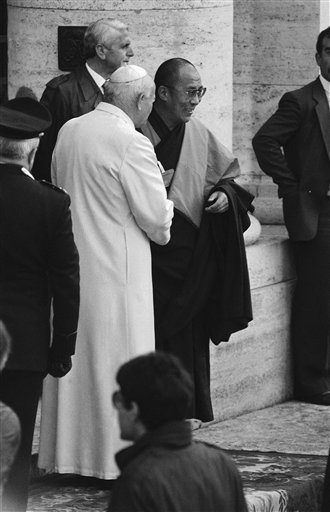
Pope John Paul II and the Dalai Lama shake hands as they met outside the basilica of Santa Maris degli Angeli where 200 representatives of 12 religions gathered for a World Day of Prayer for Peace in Assisi on Monday, Oct. 27, 1986. (AP Photo/Foggia)
Throughout more than five decades in exile, the Dalai Lama has had, as he explains himself, three principle aims. The first is to do all he can, as a Tibetan, and as Dalai Lama, for the people of Tibet. The second of his aims has been to do all he can, as a man of religion, to promote religious harmony, principally through dialogue with other faith traditions. The Dalai Lama’s third aim has been to do all he can, as an ordinary person, to serve humanity as a whole.
In respect of this desire to foster religious harmony, the Dalai Lama has established close ties with many Hindu and Sikh religious leaders. He has also been successful in fostering good relations with Jewish and Muslim leaders. He has visited both Israel and the Hashemite Kingdom of Jordan more than once.
As far as his relations with Christians is concerned, the Dalai Lama has made close friends of several Protestant churchmen, notably fellow Nobel peace laureate, the South African Archbishop Desmond Tutu with whom he has met frequently. But it is with Catholics that he has developed arguably the closest and warmest ties. He has written feelingly of his friendship with the Cistercian monk, Thomas Merton, whom he met shortly before the latter’s untimely death in 1968.⁷ The Dalai Lama also cites Blessed John Paul as a close friend and the photograph of the two men standing next to one another at the Assisi gathering in 1986 captures an optimistic moment in interfaith relations.
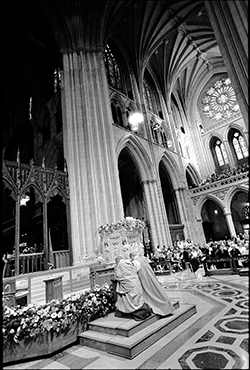
The Dalai Lama takes part in a commemorative service marking the second anniversary of 9/11 at the National Cathedral, Washington D.C., 11 September 2003. Every seat in the church is full; those who do not have a place inside remain in the vicinity, sitting quietly on the grounds of the building.
© 2005 Manuel Bauer
The Dalai Lama’s dialogue with Catholics goes far deeper than individual friendships, however. Following an early visit by him to Ampleforth Abbey in England, and with his personal encouragement, a number of exchanges between Benedictine and Tibetan monks have taken place at intervals over the past thirty years. The Dalai Lama has also enjoyed a long relationship with the World Community for Christian meditation, founded by the Canadian Benedictine John Main. And he has forged links with other Catholic orders. In 2008, for example, he was the keynote speaker at a seminar held at Blackfriars, the Dominican permanent private hall in the University of Oxford.
The Dalai Lama has often spoken of the kinship he feels for his Catholic counterparts and has even speculated that there might have been early contact between Christian and Mahayana Buddhist monastics, given some striking similarities between them. As in the Catholic tradition, chant is central to Tibetan monastic practice. Common to both are also ceremonies of consecration and invocation – similarities which prompted horrified Victorian Protestant missionaries to wonder whether the Tibetan ceremonies were in fact corrupt masses devoted not to the worship of God but to the propitiation of the devil and his minions.
But it is rather the whole phenomenon of vowed congregations living a consecrated life that is the most striking similarity between Catholic and Tibetan Buddhist practice. Celibacy, renunciation of property, prayer both public and private, lectio divina, recitation of a daily office, the veneration of saints and celebration of feast days are all to be found within Mahayana Buddhism as practised in Tibet. So too are the divisions between the cenobitic, or common life, and that of the hermit. And just as in Catholic culture, Tibetan culture reserves a special place for those virtuosi who dedicate their lives in seclusion to the pursuit of the highest mystical insights. Moreover, the traditional Tibetan monastery together with its satellite lay community run on feudal lines is remarkably similar in character to its pre-reformation Catholic counterpart.
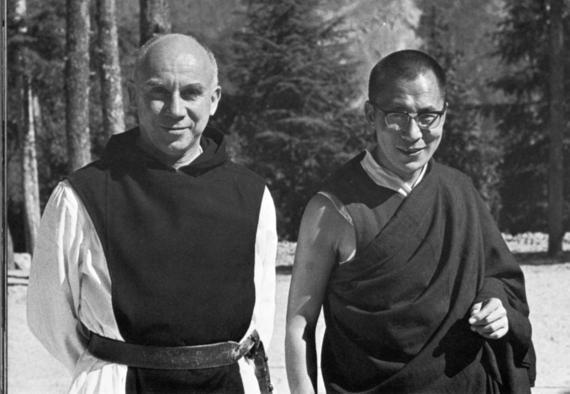
Photograph of Thomas Merton and the Dalai Lama.
Used with permission of the Merton Legacy Trust and the Thomas Merton Center at Bellarmine University
In light of this remarkable congruence, it is not surprising that many Catholics are drawn to Tibetan Buddhism. This attraction is arguably even stronger for those who are persuaded that the church is an impediment to faith. They see much of what they are familiar with in their own tradition but without the need to profess faith in God or submit to the discipline of the Magisterium. Such people may also be attracted by the fact that Buddhism does not make use of the concept of sin as it is understood by the Church. Instead, behaviours are thought of as having a positive or negative impact on the individual’s karma. What is striking, however, is that there are certain Christian writers, some of them Catholic, who advocate the adaptation or even straightforward adoption of certain Buddhist meditation techniques. The Congregation of the Doctrine of the Faith has in the past expressed grave concern about this, as does the Catholic convert from Buddhism, Professor Paul Williams⁸. Nevertheless, a few thinkers even go so far as to suggest that it is possible not merely to adopt Buddhist meditation techniques but actually to be both a Catholic and a Buddhist simultaneously. Given the radically different positions of the two traditions on the questions of Creation and of the enduring nature and intrinsic value of the self this is questionable. Nonetheless, the use of Buddhist meditation techniques by followers of other faith traditions is, for the Dalai Lama, something to be desired. He has both written and spoken of his hope that people of other faith traditions will make use of the treasures of the Tibetan tradition. From his perspective, they are a gift to share with all peoples.
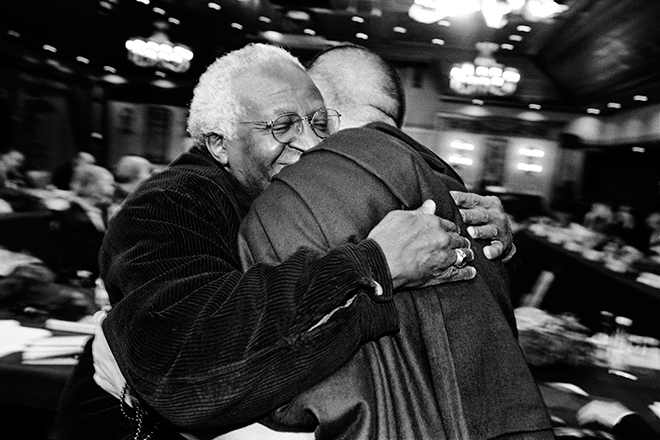
Archbishop Desmond Tutu with His Holiness the 14th Dalai Lama
Holmenkollen Park Hotel | Oslo | Norway | 7 December 2002
© Manuel Bauer
The Dalai Lama’s Spiritual Teachings
In discussing his mission to the wider world, the Dalai Lama has spoken of how he engages with different communities in different ways. When speaking to Tibetans, for example, it is with the full dignity of his office as Dalai Lama. Tibetan-speaking westerners who hear him lecturing Tibetans have often expressed surprise at the almost authoritarian manner in which, on occasions, he discharges his office.⁹
With Buddhists in general, the Dalai Lama speaks as a highly regarded scholar and teacher. He is known as a fierce debater with a capacity to argue the finest points with the utmost academic rigour. And while he clearly sympathises with those who wish to modernise Buddhist practise, he is nonetheless very much a traditionalist in matters of faith. Not for him any Second Vatican Council style overhaul of sacred liturgy. On the other hand, he has done much to encourage the – hitherto neglected – academic training of female monastics. But he has also made clear that he has no authority to introduce full ordination for women as some, notably in the West, desire.
So far as his engagement with non-Buddhists is concerned, the Dalai Lama invariably assures his audiences that his aim is not to convert them. On the contrary, he suggests that in general it is better for people to stay with whatever faith tradition they have been brought up in, or at any rate to stay with the dominant religion of the community in which they live. When speaking to these audiences he therefore generally restricts his discourse to talking about the need for what he calls basic human values: love, compassion, kindness, patience, tolerance and forgiveness. He is also careful not to offend local custom and does not draw attention to those Buddhist precepts which are at variance with them.
This habit of showing different sides, or aspects of himself to different audiences is in keeping with the Buddhist practise of using ‘skillful means’ whereby the teachings given are appropriate for and adapted to the level of those hearing it. An example of the Dalai Lama’s use of skilfull means can be seen in his public pronouncements on homosexuality. To western audiences, the Dalai Lama makes clear that individuals have every right to engage in homosexual acts. To Tibetan audiences he upholds the orthodox Buddhist position that homosexual acts are not licit. At first sight, these different teachings are contradictory. Yet to say that certain activities are the ‘right’ of individuals is not in fact to condone them. To say that it is every person’s right to criticise the Buddha is not to say that it isn’t, from a Buddhist perspective, a heinous thing to do. The same is true of homosexual acts, according to the Buddhist orthodoxy which the Dalai Lama upholds.
Arguably another use of the Dalai Lama’s skilful means can be seen in his engagement with western scientists. The Dalai Lama regularly hosts seminars and conferences devoted to exploring common points of interest between scientists and the teachings and practices of Buddhism in the Tibetan tradition. One result of this has been to encourage scientific interest in those Buddhist meditation practices which can be shown in the laboratory to confer measurably positive psycho-physiological effects on those who engage in them. This has contributed to a burgeoning movement, mainly in America, but elsewhere too, in what is called Mindfulness Training. In this, participants are encouraged to adopt a practise of daily meditation inspired by traditional Buddhist techniques. From the Dalai Lama’s perspective, this is an effective way of sharing some aspects of Buddhist practise with the wider community.
Here, though, Catholics might wish to consider the fact that, whilst it is no doubt true that Buddhist inspired meditation techniques can produce measurable physical and psychological effects, there are many resources within their own tradition which are likely to confer similar and perhaps even greater psycho-physiological benefits – to say nothing of their spiritual benefits. As Pope Benedict XVl often suggested, the Catholic tradition is so rich that there is something within it to satisfy any seeker. In this context, one might wish to explore the mystical prayer of the anonymous author of The Cloud of Unknowing or that of Brother Lawrence in his Practice of the Presence of God, to name but two of an abundance of writers on the subject of meditative prayer.
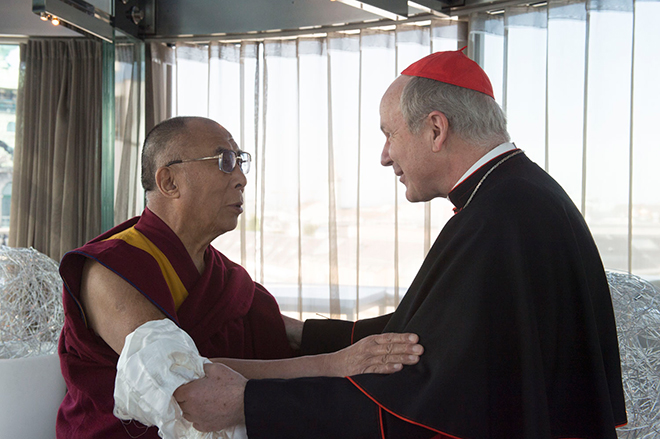
Dalai Lama and Archbishop of Vienna, Cardinal Christoph Schönborn
Vienna | Austria | 26.5.2012
© Manuel Bauer
The Dalai Lama’s Message to the World
Like Benedict XVl, the Dalai Lama is a prolific author. Both have well over a hundred separate titles to their name. One difference is that, for the most part, Benedict’s works come from his own pen, while the majority of the Dalai Lama’s are transcribed and edited compendia of his public talks. The Dalai Lama is more of a teacher than an author as such. That said, he has written, or has at least been in the largest measure responsible for a number of books aimed at a popular audience. Two of these are devoted to what he calls ‘secular ethics’. In these, the Dalai Lama sets out his argument that ethics can and should be taught without recourse to religious principles. This claim reflects his view that ‘religion alone cannot answer all our problems’.¹⁰
For himself, the Dalai Lama explains, religion is like tea. Some prefer it with milk, some without. Some like it with sugar, some don’t. Tibetans take theirs with butter and salt. The one thing that is common to all types of tea, however, is water. Without water, there is no tea. In the same way, he says, religion varies in all kinds of different ways. The one thing common to all of them, however, is their emphasis on love and compassion. These qualities are expressed in the basic human values of kindness, generosity, patience, tolerance and forgiveness that are the hallmark of all religions, whether underpinned by a belief in one God, many gods or no transcendent being at all. Moreover, just as even the person who does not drink tea must drink water in order to live, so too those who have no religion at all need love and compassion in their lives.
The Dalai Lama goes on to suggest that it doesn’t matter whether one is a Buddhist, a Christian, a Hindu, a Muslim or a Jew or indeed whether one is none of these things. What does matter is whether or not one is compassionate.
This is a startling claim for a major religious figure to make. For the Dalai Lama to say that it makes no difference which faith a person espouses provided they are compassionate seems to suggest that he has no good reason to uphold his own Buddhist faith. And yet he remains steadfast in his commitment, as a celibate monk, to leading a life wholly dedicated to that tradition. At first sight, the two positions are contradictory.
But again, appearances are not all they seem. To begin with, as the Dalai Lama explains, his faith is the guarantor of his compassion. It is what frames and contextualises his daily life. But this, he says, does not mean that Buddhism is the most suitable religion for everyone. Indeed the Dalai Lama does not believe it could ever be possible to find one religion that is suitable to all the different mental dispositions at large in the world.
Partly for this reason, the Dalai Lama does not endorse attempts to ‘square the circle’ between the different faiths of the world. To try to do so, he says, is akin to ‘putting a yak’s head on the body of a sheep’. It can’t be done. Far better, in his opinion, is to concentrate on the basic human values which unite all traditions while yet adhering to that particular tradition.
There is, of course, a problem here. Every major religion, including Buddhism, makes some claim to being the exclusive path to salvation. Although following the second Vatican Council, the Church has interpreted the saying extra ecclesiam nulla salus in a positive rather than a negative way, the doctrine remains an article of faith. Outside the Church, there is no salvation. Similarly, for Buddhists, full Enlightenment is not available to any being which is not ‘established on the path’ of Buddhist teaching. Crudely put, being a Buddhist is a necessary condition of full Enlightenment.
What this means from a Buddhist perspective is that, while being a Christian or a faithful follower of some other faith tradition may well be adequate to this lifetime insofar as that person learns to practise compassion, in other lifetimes, they will have to become Buddhist in order to attain full and final liberation from suffering.
The Dalai Lama’s insistence that compassion and not religion is what really matters has found favour in many quarters, especially among those who seek to develop spiritually without recourse to institutional religion. But is it true? It is important to realise that the claim rests on two assumptions. The first assumption is that when a being exercises compassion, they are, in the most important sense, manifesting the compassion of the Buddha. The second assumption is that the doctrine of rebirth is true.

H.H. the Dalai Lama with students…
© Tenzin Jamphel / OHHDL. Details: Official Dalai Lama Facebook Site
This first assumption would, however, turn out to be false if it were true that human beings were nothing more than constellations of matter in empty space. Compassionate acts might then turn out to be related in some way to the evolutionary imperative. On the other hand, if Christianity is right, compassion is an expression of the love of God.
The second assumption could also turn out to be false. There might be no such process as rebirth. If materialism is right, death is the end of everything. Similarly, the Catholic church has never endorsed the theories of rebirth or reincarnation. It has been suggested that some of the Church Father did so. But while it is true that the Alexandrian theologian Origen (c185-c254) seems to have believed in the pre-existence of souls and in final redemption for all, including the devil (the doctrine of apokatastasis) – Origen himself explicitly denied the doctrine of the transmigration of souls and hence anything like rebirth in the Buddhist sense. It is false to suggest that the theories of rebirth or reincarnation have ever been endorsed by the Church. In fact, the Church has always upheld St Paul’s words in the letter to the Hebrews that ‘it is appointed to men to die once and after this comes the judgement’.¹¹
For it to be correct that a person’s religion does not really matter, as the Dalai Lama maintains, either death would have to be the end of everything for us, or it would have to be the case that Almighty God Himself is indifferent to which religion we profess. Certainly this has never been the teaching of the Church. However, if it were to turn out that what follows is rebirth understood in the Buddhist sense, and if the state of what survives into the next life is affected by how compassionate our actions in this life are, then compassion might well be more important than which religion we follow. But if our eternal destiny depends on this life alone and, more than that, if our salvation is, as the Church teaches, inescapably bound up with our faith, it follows that it matters a great deal which religion we confess.
The Significance of the Dalai Lama
The enormous popularity of the Dalai Lama in the notionally Christian countries of the world attests at the very least to a great spiritual hunger. It also suggests that that hunger is not being fully satisfied by the Christian churches. There could be many reasons for this, including underemphasis on the mystical aspects of the tradition, a lack of rigour in modern catechesis, the loss of Latin and so on. All this is open to argument. But what cannot seriously be in doubt is the tremendous appeal of an individual of the highest personal integrity who is, to paraphrase St Paul, self-evidently someone who would sooner bless than curse his enemies, who to the utmost of his ability seeks to be at peace with everyone, who trusts and hopes in a better future both for his own people and for humanity as a whole.
Of course, St Paul is using these terms to describe Christian love: the love that we are instructed by Christ to have for one another. This is evidently very close to the love which the Dalai Lama advocates when he speaks of compassion. Yet Christians have a prior commitment. The first commandment says: ‘You shall love the Lord your God with all your heart, and all your soul and all your mind’.¹² It is surely this, and all that it entails, whatever it entails, that is the Christian’s first duty.
Modern culture rightly sets great store by authenticity and the Dalai Lama is clearly authentic both in his practise of the Buddhist religion and in his desire to serve others. As Catholics, we may not accept the Dalai Lama’s claim that the religion we espouse does not matter. Yet there is certainly much that is inspiring about the Dalai Lama’s insistence on the value of compassion and insofar as this encourages people to search out the true meaning of our earthly existence, we may surely see in the Dalai Lama’s message a genuine ‘preparation for the Gospel’.¹³ ■
Notes
¹ This should not be taken to mean there is any doubt that the Fifth was correctly identified, however.
² A disciple is said once to have asked the Buddha how long an eon lasts. He replied with an analogy: ‘Suppose there was a great mountain seven miles wide and seven miles high, a solid mass of rock without any cracks. At the end of every hundred years, a man might brush it with a fine Benares cloth. That great mountain would be worn away and come to an end sooner than ever an eon.’
³ In Sanskrit, Avalokiteshvara.
⁴ The word dalai is a Tibetanised rendering of the Mongolian taleh meaning ocean hence ‘Ocean Lama’; the Tibetan word gyatso [correctly, rgyam mtsho], which is shared as a name by all Dalai Lamas save the first, also means ‘ocean’. Hence the Dalai Lama is the Ocean Lama, understood to mean the lama whose wisdom is wide as the ocean.
⁵ Robert Ekvall quoted in SL p101
⁶ The teams were lead by Dr Herbert Benson
⁷ Merton repays the compliment both in his Asian Journal and in his letters home.
⁸ See CTS publications Meditation, xx [details] and Buddhism [details]
⁹ Remarkably perhaps, there are Tibetans who argue that the Dalai Lama’s pronouncements in certain matters of faith are restrictive to the point of intolerance. His proscription of worship of a popular deity known as Dorje Shugden has caused much bitterness among sections of the population. See Secret Lives for a full account.
¹⁰ Beyond Religion p3
¹¹ Hebrews 9.27 but cf also Lk 16.19-31;23.43; 2 Cor 5.10
¹² citation needed
¹³ Lumen Gentium section 16.

ALEXANDER NORMAN holds a BA in Philosophy and Theology and an MSt in Oriental Studies from the University of Oxford.
He is a long-time associate of HH the Dalai Lama, having worked closely with the Tibetan leader on his autobiography, Freedom In Exile (London 1990, Hodder and Stoughton); Ethics For The New Millennium (London 2000, Little Brown) and Beyond Religion: Ethics For a Whole World (Boston 2011, Houghton Mifflin Harcourt). In addition, he has served as a speech writer for HH the Dalai Lama and on the Tibetan leader’s Special Review Committee. He is the author of Holder Of The White Lotus, a history of the Dalai Lama institution, and of an acclaimed biography of the Dalai Lama, The Dalai Lama: An Extraordinary Life (Boston 2020, Houghton Mifflin Harcourt).
He is President of the London-based charity, Help Tibet and he is Director of The Dalai Lama Centre for Compassion, Oxford, UK.
Header image: © Manuel Bauer His Holiness the Dalai Lama in Vienna, Austria, 27. May 2012
See also
- Differing Perspectives, Compassion in the Buddhist and Christian Traditions – Alexander Norman
- The 14th Dalai Lama: The Making of a Spiritual Hero by Stephan Talty
- From Protective Deities to International Stardom: An Analysis of the Fourteenth Dalai Lama’s Stance towards Modernity and Buddhism by Georges B. Dreyfus
- The 14th Dalai Lama - Biographical by NobelPrize.Org
- The Fifth Dalai Lama and his Reunification of Tibet by Samten G. Karmay
- The Thirteenth Dalai Lama, Tubten Gyatso by Tsering Shakya

